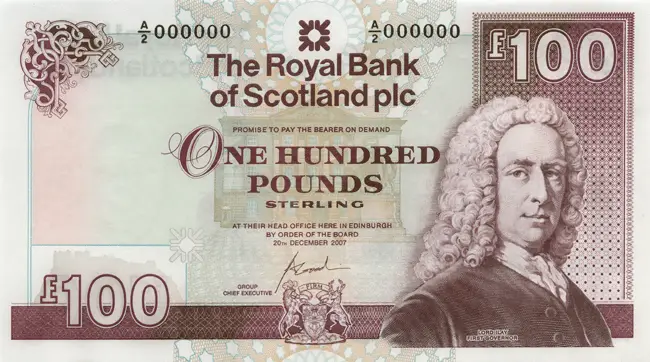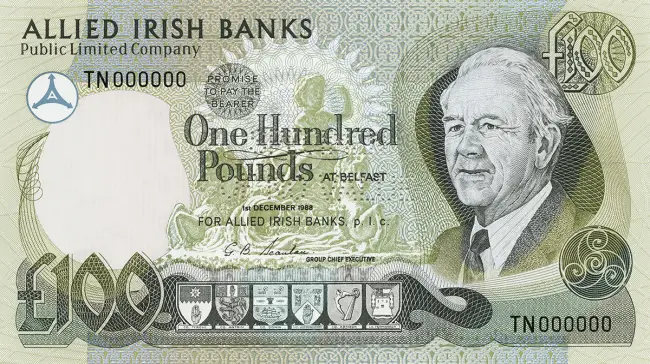Ask anyone to name the largest Uk banknote denomination and they’ll say the £50 note without hesitation, but is there a £100 note?
There are in fact two types of £100 notes – one issued in Scotland that was first issued in 1727 and one in Northern Ireland that was issued in 2005.
This topic can get a little confusing, so if you want to learn more about these elusive notes and where they can actually be spent then keep reading.
Scottish £100 Note
The Scottish £100 note was first introduced in 1727, the year the Royal Bank of Scotland (RBS) was formed.
According to this calculator, the value of £100 in 1727 in today’s money is around £6,000 taking into consideration the increase in Retail Price Index (RPI); meaning whoever managed to get hold of one of these notes back then was clearly very fortunate.
These early editions of the £100 note were only printed on one side and had a monochrome colour scheme. Fast forward to 1987 when the current version of the £100 note was brought into circulation.
Known as the ‘Ilay’ series, the obverse of these £100 notes features a design with Lord Ilay visible towards the right-hand side, with Balmoral Castle featured on the reverse.
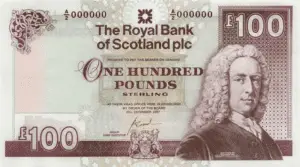
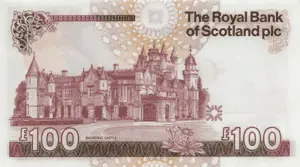
The Ilay series was succeeded by the Bridges series, which has recently been replaced by a new £100 note featuring Dr Flora Murray.
Can You Spend A Scottish £100 Note?
All Scottish banknotes are legal currency in the United Kingdom, meaning they are approved by the UK Parliament. However, things get complicated in regards to legal tender.
Scottish banknotes are not legal tender anywhere, including in Scotland!
According to the Bank of England, legal tender means that if you offer to pay off a debt to someone in legal tender, they can’t sue you for failing to repay; which has very little application in day-to-day terms.
In practical terms, it means that Scottish notes are regularly circulating and accepted in Scotland. In the rest of the United Kingdom, however, you might find difficulty with getting Scottish banknotes accepted.
Funnily enough, you would find it a lot less difficult in using English banknotes in Scotland rather than the other way around.
Where Can You Get A Scottish £100 Note?
It’s very unlikely that you would come across a Scottish £100 note in daily life – it isn’t like you would get a £100 note in your change or be paid with them.
You can opt to purchase one of the notes online on sites like eBay, but this can be a risky business given how valuable the note is.
Irish £100 Note
The Bank of Ireland £100 note is, unsurprisingly, the largest denomination of banknotes that they issue. Although the bank itself was formed in 1783, it was not until 2005 that it started to issue £100 notes.
The note was issued as part of the Queen’s University Belfast Series and the design has not changed to this day; featuring a depiction of Hibernia on the obverse with a shield of arms, and the reverse with an image of Queen’s University in Belfast.
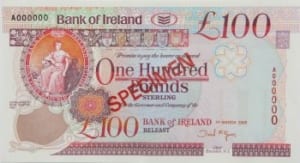
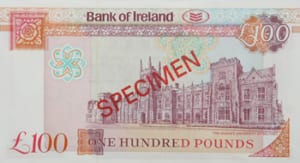
Unlike the majority of other Northern Irish banknotes that were replaced by the Bushmills Series in 2008 the £100 note has remained with the same design.
Allied Irish Banks p.l.c £100
Allied Irish Banks also issued their own £100 notes in the form of the Armada series which has been in circulation since 1988. The designs for this note can be seen below.
This note has ceased to be legal tender on 30th June 2022, leaving the Bank of Ireland £100 note behind.
Can You Spend An Irish £100?
Similarly to Scottish banknotes, all Irish banknotes are not legal tender anywhere in the UK, including Ireland itself, but they are legal currency.
This means essentially the same principles apply as with the Scottish banknotes, so you can use the notes in Northern Ireland and they will be readily accepted but you will struggle to use them anywhere else in the UK.
It is important to remember that the Republic of Ireland uses the Euro, so the same principles will not apply there.
Where Can You Get An Irish £100 Note?
Unfortunately, the Irish £100 notes are just as rare to come by as the Scottish, and it’s likely that you’ll have to purchase one online if you want to get your hands on one quickly.
Fake Notes And The £100 Note
The simple fact of the matter is that Scottish and Irish notes are not very common at all in the rest of the UK, and for this reason, many shopkeepers will be unwilling to accept these notes as they will suspect them to be fake.
This becomes even more apparent when you consider that not many people actually realise there is such thing as a £100 note.
A funny-looking £20 note is enough to cause shopkeepers to suspect something is wrong, imagine the reaction you would get if you offered a £100 note for payment somewhere in England or Wales!
Final Thoughts
The bottom line of this conversation is that all banknotes are the same currency – British Pounds Sterling – and this is not affected by where they are produced.
The Banks of Scotland and Ireland are within their rights to produce their own notes in celebration of their history and culture, and these should be rightfully accepted anywhere within the UK. It is hypocritical that the Bank of England notes are much more accepted within the UK than the other notes produced in Scotland and Ireland, but unfortunately, it is just the way things are.
In regards to the £100 note, it is perhaps more understandable why these are even less likely to be accepted.
£50 notes issued from the Bank of England are generally frowned upon as payment within England or Wales as it is, so it’s probably not worth the hassle of using one as payment.
Although in practicality the chances of somebody having one of these notes from either Scotland or Ireland and then trying to spend it somewhere else in the UK is very slim… but it’s good to be informed of the facts!
If you would like to learn more about where certain coins and notes can and can’t be spent, check out our articles on Guernsey or Jersey.
